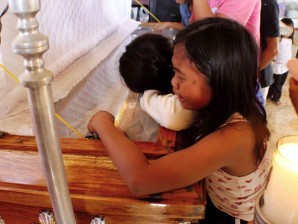
THE DAUGHTERS of Cristina Jose grieve for their mother during Cristina’s wake in her home in Baganga. PHOTO FROM KARAPATAN
BAGANGA, Davao Oriental—She survived when a typhoon hit this town in December last year. But three months after Typhoon “Pablo” ravaged this town, Cristina Jose, 40, mother of three, wife to husband Danilo, and a village councilor in the remote village of Binondo, did not survive the bullet that pierced her body and exited her breast.
She was about to book a van to return to Davao City, where she wanted to report threats that came after she joined protests at the Department of Social Welfare and Development (DSWD) regional office. She did not make it to the Barangay Central where the vans were parked. Around
6 p.m. of March 4, she was gunned down by three men on a motorcycle.
Witnesses said the unidentified assailants were all wearing black shirts and short pants, and the red Honda TMX motorcycle they were riding had no license plate. Human rights group Karapatan was quick to point an accusing finger at state agents.
A witness to the killing (whose name could not be disclosed for security reasons) said the motorcycle that Cristina rode had been followed by unidentified men who had put her under surveillance.
The men on motorcycle had overtaken them as they reached a gasoline station and nearly ran over a child. Cristina told her cousin, who was driving their motorcycle, to slow down and let the trailing motorcycle pass. The motorcycle behind them slowed down, too. Then Cristina heard a gunshot, thinking at first that it was a tire exploding.
“It was only after she saw the blood on her chest that she said, ‘It was me who got hit, they shot me, please help me,’” the witness said.
“She was well-loved by the people,” her husband said of Cristina at the wake in their two-story house in Barangay Lucod.
“When people are in trouble, they usually come to her for help, especially when they needed to send someone to the hospital. She was always there to help,” he said.
Seconds after she was gunned down, a cousin had asked a passing tricycle for help but the driver said, “I don’t take that kind of passenger,” eyeing Cristina, who was then losing consciousness, bloodied.
About 10 minutes later, the cousin’s friend happened to pass by and helped bring Cristina to the nearest lying-in clinic, where she had been pronounced dead on arrival.
“It rained the night they gunned her down, and the following day, it rained again so that you would almost see nothing on the pavement now, except for a stain that resembles rust,” said Hanimay Suazo, a member of Karapatan who rushed to the crime scene to check.
Danilo said Cristina’s life started to be in danger when she joined the human barricade in Montevista, Compostela Valley, on Jan. 15, demanding the speedy release of aid to starving Pablo survivors in Baganga.
The human barricade stopped traffic from the Davao to Agusan route that day. When they returned to Binondo village the following day, they noticed government troops stationed in the barangay.
An armed clash between government troops and the communist New People’s Army (NPA) occurred in the neighboring village of Lumot that day, but Cristina’s cousin said the commanding officer of the 67th Infantry Battalion told neighbors to be wary of Cristina because she is a “barangay kagawad of the NPA,” responsible for bringing rebels to Lumot.
Lt. Col. Krishnamurti Mortela, however, denied this, saying the Army has kept a good relationship with Cristina, as they, too, condemned the killing.
According to Karapatan, a soldier told Cristina’s neighbor in Binondo to “watch out” for Cristina because she had allowed the NPA inside Blackstone, a place in Sitio Limot in Barangay Binondo, where the January clashes between the NPA and government troops occurred.
Another neighbor in Barangay Lucod was also told by another soldier and former rebel returnee named “Max,” that Cristina will not “live that long.”
Karapatan also said Cristina had “countless disagreements” with Mortela, an allegation that the military officer denied.
Mortela said the Philippine Army has been in “good terms” with Cristina.
“I don’t want to dishonor her memory by saying negative things about her,” Mortela said in a phone interview. “From the very beginning, she was so concerned about peace in the community, and had asked us to work in tandem with local officials to give education to the children.”
Mortela also denied they had linked Cristina with the NPA. He also said that the distribution of relief goods in the area has been “well-organized,” and that there was a system that was followed for the release of relief goods.
From Feb. 25-28, Cristina led 84 villagers from Binondo to Davao City, where they took part in the four-day camp outside the DSWD office. There, Pablo survivors took matters into their hands and raided the DSWD warehouse.
After returning to Baganga on March 1, villagers were told by a purok leader they will no longer receive relief goods from the government after they participated in the DSWD protest. It was Cristina who checked this with police and military authorities.
“Many people have been saying her actions did not sit well with local authorities,” Danilo said. “Neighbors are saying local authorities were angry.”
On March 1, Cristina sent a message to Karapatan telling the human rights group that soldiers have threatened to put them on a list of people who will no longer receive aid.
The threats prompted Cristina and four other typhoon survivors to return to Davao City to report the alleged “harassment.” But before this, Cristina joined the March 4 village council session which ended at 3 p.m. that day. She took a late lunch at home before rushing on to book a van for her trip to Davao City. Halfway through the bridge of Baganga, she was killed.